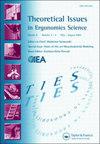Driver propensity to fatigue and drowsiness: a probabilistic approach
IF 1.4
Q4 ERGONOMICS
引用次数: 1
Abstract
Abstract This analysis is aimed at quantification, on the probabilistic basis, of the significance of driver fatigue and drowsiness (DD) in automated and manual driving conditions; the impact of driving time on the probability of an accident, because of the driver’s fatigue and possible drowsiness, and the observation that age groups of 20–25 and 65–70 are more prone to making a human fatigue and/or DD related error than the 26–64 old group. Our analyses are based on the application of the recently suggested double exponential probability distribution function (DEPDF), and on using entropy and adequate-trust based considerations. The general concepts are illustrated by numerical examples. It is concluded that analytical modeling technique employed in this study should complement, whenever possible, statistical analyses and computer simulations in challenging ergonomics tasks, including those of the type in question.驾驶员疲劳和嗜睡倾向:一种概率方法
摘要本分析旨在在概率基础上量化自动驾驶和手动驾驶条件下驾驶员疲劳和嗜睡(DD)的重要性;由于驾驶员的疲劳和可能的嗜睡,驾驶时间对事故发生概率的影响,以及观察到20-25岁和65-70岁年龄组比26-64岁年龄组更容易出现人类疲劳和/或DD相关错误。我们的分析是基于最近提出的双指数概率分布函数(DEPDF)的应用,以及基于熵和充分信任的考虑。通过数值例子说明了一般概念。结论是,本研究中使用的分析建模技术应尽可能补充具有挑战性的工效学任务中的统计分析和计算机模拟,包括所讨论的类型的任务。
本文章由计算机程序翻译,如有差异,请以英文原文为准。
求助全文
约1分钟内获得全文
求助全文

 求助内容:
求助内容: 应助结果提醒方式:
应助结果提醒方式:


